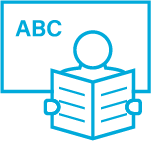


There are approximately 750 million illiterate adults globally who could (in principle) learn fluent reading. However, adult literacy programmes have thus far performed poorly. The author posits the hypothesis that all people become dyslexic toward new alphabets at the approximate age of 19 years, and the ability to read new alphabets fluently decreases with age.
Author: Helen Abadzi
Source: Abadzi, H. (2019). Neo-literate adult dyslexia and literacy policies: A neurocognitive research review of a curious unexplored phenomenon. Current and Critical Issues in Curriculum, Learning and Assessment, in progress-reflection nro 29, IBE/2019/WP/CD/29.
There are approximately 750 million illiterate adults worldwide who could (in principle) learn fluent reading. However, adult literacy programmes have thus far performed poorly. In this paper, the influence of some neurocognitive factors on poor adult reading performance is explored. Automatic readers of a script detect letters and words effortlessly and involuntarily. Adults learning a new script detect letters slowly, may make mistakes, understand little, soon abandon the task, and may also forget what they have learned. When a neo-literate person (a person who does not yet know how to read the alphabet) glances at a text, they may only see a jumble of letters and may only process some of the features. They must activate reading consciously and sound out each letter. Their difficulties are perceptual, and interviews suggest that perceptual distortions may continue for decades. This phenomenon termed ‘neo-literate adult dyslexia’ (NAD) has received little attention to date. The problem occurs in the brain, and may originate at the early stages of development of the parietal cortex at the dorsal reading path, which constricts short-term visual memory. Parts of the visual cortex (the striate cortex V1, and perhaps the extra-striate cortex V4) may also be involved. Deficits affect the ventral path that provides parallel processing and direct print-to-meaning reading. Some neuronal groups may have a sensitive period that affects the capacity to collect frequency data and to integrate the appropriate features of letters and words. Then, adults do not learn to perceive letter shapes and words as easily as most children do. These difficulties for adults are not linguistic. Dysfluent readers simply cannot decipher the symbols within a sufficient time to acquire the meaning of texts (or they do so after considerable conscious visual effort). Some adults may become better readers than others. However, there seems to be a correlation between learning a script at increasingly later ages and worse reading outcomes, although no data exists to map this trajectory. To explore this curious phenomenon, this review brings together a range of insights from of neurocognitive research, notably studies on a) perceptual learning, b) neurocognitive studies aimed at dyslexic children, c) studies of adult suffering from brain damage that causes alexia, and d) performance of adult literacy programmes. The author posits the hypothesis that all people may become dyslexic toward new alphabets from the approximate age of 19 years, and that ability to read new alphabets fluently decreases with age.
Background
The neo-literate adult dyslexia hypothesis
Observations by an ‘illiterate’ reading specialist
The basic neuroscience of reading
The role of implicit memory in reading
Statistical learning of visual stimuli
Perceptual learning: letters as objects, then words as faces
Feature integration in perceptual learning
Performance of unschooled illiterate people during or after reading instruction
Educational programmes for teaching illiterate adults: results
Where are neo-literate adult dyslexia deficits located? Some hypotheses

Conclusions and implications
The research highlights some issues that are relevant to policy and instruction, as follows:
Instructional and policy implications
Potential remedies for performance improvement